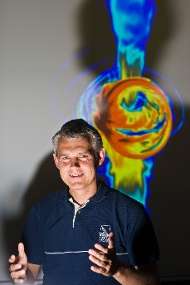Heino Falcke
Heino Falcke (born 1966) is a German professor of radio astronomy and astroparticle physics at the Radboud University Nijmegen. He was a winner of the 2011 Spinoza Prize.[1] His main field of study is black holes. In 2013, a team under his lead earned a 14 million euro research grant from the European Research Council to further studies of black holes.
Heino Falcke | |
|---|---|
 Heino Falcke (2011) | |
| Born | 1966 (age 53–54) Cologne, Germany |
| Nationality | German |
| Occupation | professor of radio astronomy and astroparticle physics |
| Awards | 2011 Spinoza Prize |
| Academic background | |
| Alma mater | University of Cologne, University of Bonn |
| Academic work | |
| Institutions | Radboud University Nijmegen |
Career
Falcke was born in Cologne, Germany in 1966.[1] He studied physics at the universities of Cologne and Bonn and graduated in 1992. He obtained a doctorate summa cum laude in 1994 from the University of Bonn.[1] Falcke subsequently worked as a scientist for the Max Planck Institute for Radio Astronomy in Bonn, the University of Maryland, and the University of Arizona.[1]
Falcke won the Ludwig Biermann Award for young astronomers of the German Astronomische Gesellschaft in 2000.[2][3]
In 2003, he became adjunct professor of Radio Astronomy and Astroparticle physics at Radboud University Nijmegen. He also started working for ASTRON, the radio astronomy institute of the Netherlands. In 2007, he became a full professor at Nijmegen.[1]
In 2006, Falcke won the Academy Prize of the Berlin-Brandenburg Academy of Sciences and Humanities.[3][4]
Falcke received an Advanced Research Grant of the European Research Council of 3.5 million euro in 2008.[3] In 2011, he was one of three winners of the Dutch Spinoza Prize and received a 2.5 million euro grant.[5] The organization presenting the award, the Netherlands Organisation for Scientific Research, praised Falcke for providing new insights regarding black holes. They also called him one of the leading forces behind the radio telescope LOFAR.[1] Falcke worked on the design of the telescope.[3]
In 2013, Falcke, as lead scientist of a team, received a European Research Council Synergy grant of 14 million euros. The grant was intended for further studies of black holes, specifically Sagittarius A*.[6][7] The goal was to construct a Black Hole Camera with the grant.[8] This would allow testing of Albert Einstein's general theory of relativity by creating an image of the event horizon.[6] This project culminated into the Event Horizon Telescope project; within this project, Falcke is the chair of the EHT Science Council.[9] On 10 April 2019, he announced that the project managed to create an image of the black holes at the centre of the Milky Way (Sagitarius A*) and M87.[10]
Since 2014, Falcke has been a member of the Royal Netherlands Academy of Arts and Sciences.[11]
Research
Falcke is involved in theoretical astronomy as well as observational and experimental studies.[12] Apart from his work with LOFAR, he is also involved in the development of the Square Kilometre Array.[12]
In 2000 he predicted it would be possible to make measurements near the edge of a black hole. Four years later, his team managed to do that.[12] In 2013, Falcke, together with Luciano Rezzolla of the Max Planck Institute for Gravitational Physics. proposed that blitzars could be an explanation for fast radio bursts.[13] Blitzars would occur when a supramassive rotating neutron star slows down enough, loses its magnetic field, and then turns into a black hole.[14][15]
Falcke predicted that near the edges of a black hole, there would be a 'black hole shadow' that could be detected by a radio telescope.[3]. This shadow was eventually observed with the Event Horizon Telescope.
Falcke wishes to place a radio telescope on the Moon and has worked with NASA and European Space Agency researchers to devise a plan to make this happen.[3].
Personal life
Falcke is a devout Christian and serves as lay pastor in the Protestant Church in the Netherlands.[16] He views his faith as a way of achieving internal rest, as well as a motivation to conduct science.[16]
References
- "Prof. H.D.E. (Heino) Falcke". Netherlands Organisation for Scientific Research. 26 August 2014. Retrieved 25 July 2015.
- "Recipients of the Ludwig Biermann Award". Astronomische Gesellschaft. Retrieved 26 July 2015.
- "Heino Falcke receives highest Dutch scientific award" (in Dutch). ASTRON. 7 June 2011. Retrieved 25 July 2015.
- "Akademiepreis 2006" (in German). Berlin-Brandenburg Academy of Sciences and Humanities. Retrieved 26 July 2015.
- "NWO Spinoza Prize 2011". Netherlands Organisation for Scientific Research. 26 August 2014. Retrieved 25 July 2015.
- "14 miljoen euro in zwart gat". De Telegraaf (in Dutch). 18 December 2013. Retrieved 25 July 2015.
- "14 miljoen voor onderzoek Heino Falcke naar zwarte gaten" (in Dutch). Radboud University Nijmegen. 17 December 2013. Retrieved 25 July 2015.
- Govert Schilling (4 January 2014). "Maken we over vijf jaar foto's van zwarte gaten?". de Volkskrant (in Dutch). Retrieved 25 July 2015.
- "Organization - Event Horizon Telescope". EHT Collaboration. Retrieved 12 April 2019.
- "First ever black hole image released". BBC News. Retrieved 11 April 2019.
- "Heino Falcke" (in Dutch). Royal Netherlands Academy of Arts and Sciences. Retrieved 25 July 2015.
- "Heino Falcke kijkt verder dan de horizon van het zwarte gat" (in Dutch). Radboud University Nijmegen. Retrieved 26 July 2015.
- Govert Schilling (4 July 2013). "Mystery radio bursts blamed on black hole 'blitzars'". New Scientist. Retrieved 26 July 2015.
- "Afscheidsgroet van een stervende ster" (in Dutch). Radboud University Nijmegen. 4 July 2013. Retrieved 26 July 2015.
- John Timmer (8 July 2013). "Possible explanation for radio bursts: Meet the "blitzar"". Ars Technica (in Dutch). Retrieved 26 July 2015.
- Ellen Nieuwenhuijze (15 March 2013). "Wetenschap beantwoordt niet alles". Trouw (in Dutch). Retrieved 25 July 2015.